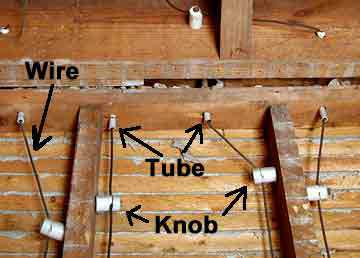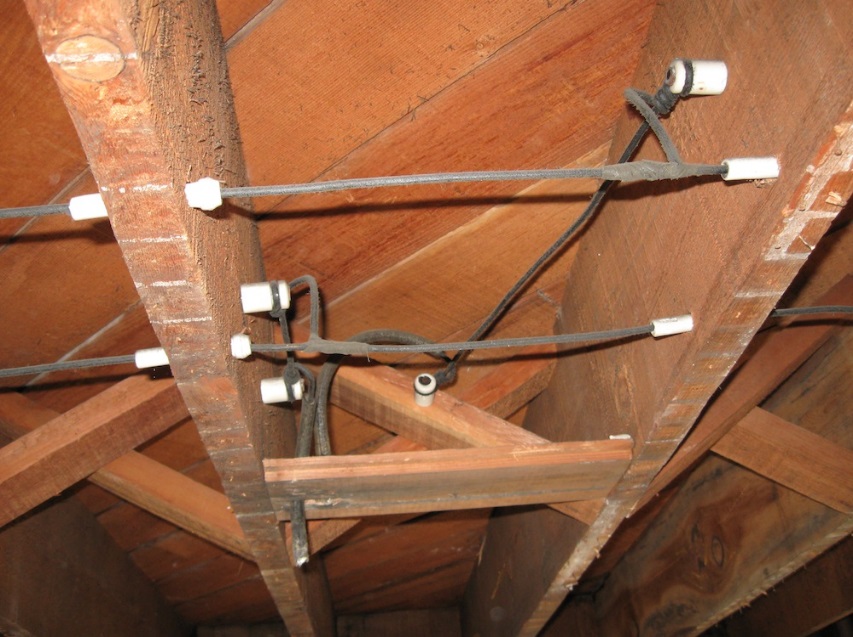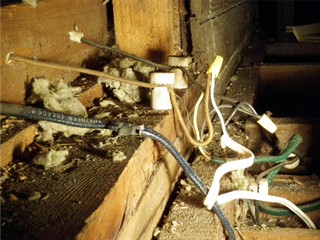Knob & Tube Wiring
Knob and Tube Wiring, also called Open Wiring, was a common wiring method used in the 1900’s to the late 1940’s. It is estimated that there were approximately 200,000 homes, with Knob & Tube Wiring, built in ON during this time.

Knob & Tube Wiring is a single conductor, ungrounded system, where electricity is brought from a 60-amp service to different areas of the home by running copper wires, covered with a cloth and rubber insulation sheathing, through the walls, attic and floor spaces. As seen in the photo, porcelain knobs are used to secure the wires in place and keep them from contacting combustible surfaces. Where ever the wire needs to cross through a stud or joist, holes are drilled and fitted with porcelain tubes through which the wire has been threaded, thus the name, Knob & Tube Wiring. The alternate name of Open Wiring suggests the importance that an open airspace be maintained around the wire at all times to prevent overheating.
IS KNOB AND TUBE WIRING SAFE?

If the Knob & Tube Wiring system remains unaltered, has been carefully maintained, and all repairs have been made by a knowledgeable electrician, this wiring method would still be safe to use today. Unfortunately, this is almost never the case. As the system ages and deteriorates, porcelain knobs and tubes may crack or break, old wires sag and fray, and the sheathing turns brittle and falls off, exposing the live wires. Homeowners improvise their own repairs as replacement parts may not be readily available which results in some very dangerous modifications.

Homeowners unknowingly create a dangerous situation when household insulation is installed over the wires. The cloth/rubber sheathing around the wires is not approved for contact with insulation as it requires an unrestricted airspace around it to dissipate any buildup of heat. Add to this picture the unsafe practice of modifications made to modern appliance cords in order to make them compatible with the old and outdated 2 prong receptacles, extensive use of extension cords and power bars in order to glean more power than the aging electrical system was intended to provide, and you have the potential for a serious problem.
A combination of Knob and Tube Wiring and modern wiring is what is usually found in these older homes today. If this work has been done by someone unfamiliar with the unique requirements of Knob and Tube Wiring, the potential for disaster is certainly present. The tinder dry beams in this attic would have been instant fuel for a spark from this dangerous wiring combination of old and new. But in many cases the “updating” is not visible in the attic or basement. Rather, it is hidden behind the walls as it was probably done during a previous renovation or addition to the house.
Aside from deterioration as a result of age, the majority of problems with Knob and Tube Wiring are caused by tampering and when alterations are made to the original system by amateur handymen. So, to answer the question of whether Knob and Tube Wiring is safe, the answer is NO. This method has long out lived it’s time and should be replaced with current products and modern procedures.
DOES KNOB AND TUBE WIRING AFFECT INSURANCE RATES?
Insurance companies are wary of homes with knob and tube wiring and view this wiring method to be a definite safety hazard, and therefore a claim waiting to happen. Some of our clients have reported paying extremely high insurance rates as a result of the Knob & Tube Wiring. At the very least, an inspection by a certified electrical contractor is requested which, given the information shared above, usually requires that the knob and tube be completely replaced before a homeowner’s policy is issued or renewed. This leaves the homeowner with little choice but to address the problem.
WHAT IS THE BEST KNOB AND TUBE SOLUTION?
Realistically, complete replacement of the old wiring is the best option. The presence of Knob and Tube Wiring means the house was probably built 60 to 100+ years ago when this was the only wiring method available. Demands on the home’s electrical system were minimal back then, as lighting was often spartan at best, and homeowners owned only a few small electrical appliances. Fast forward to today and compare this to your daily electrical needs and you soon realize just how out dated the Knob & Tube system is.
Removing the old Knob & Tube wiring and replacing the entire system with new copper wiring to meet today’s Electrical Safety Code standards is without question the best solution. Replacing the old ungrounded switches and receptacles with CSA approved devices is another important safety measure. If it has not already been done, installing a new electrical service panel at this time, that provides for the needs of today’s average household usage and also allows for any possible future needs or plans, addresses the problem of blown fuses, over loaded circuits and other safety concerns.